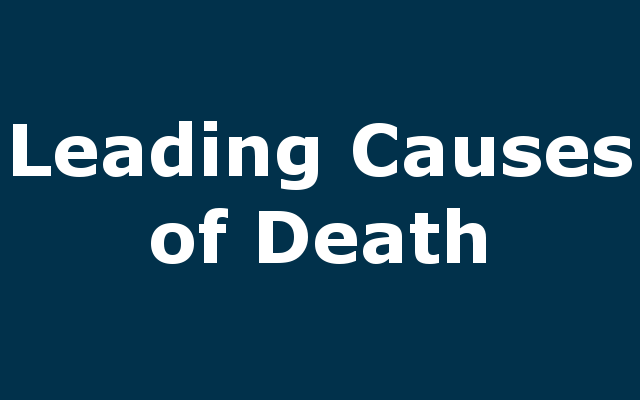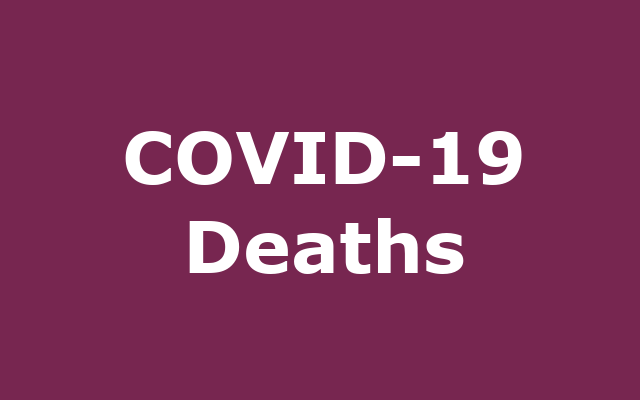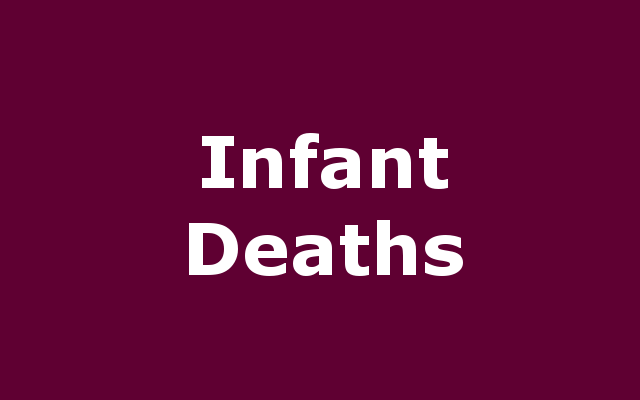Mortality and Leading Causes of Death
Quick Links

|

|

|

|

|
Leading causes of death are those causes that account for the highest numbers of deaths for a given population and time period. They vary by geographic area, age, race, ethnicity, gender, and other demographic factors. Leading cause of death rankings are based on the underlying cause of
death and there is a standardized list of 52 causes of death eligible to be ranked as leading causes.
In 1951, the Public Health Conference on Records and Statistics recommended that state and federal agencies responsible for identifying diseases of public health importance adopt a uniform ranking procedure using a standard list of causes of death. The procedures implemented in 1952 are essentially
the same as those currently used by the Centers for Disease Control and Prevention's (CDC) National Center for Health Statistics (NCHS); however, the cause-of-death lists have been expanded and altered over time with each subsequent revision of the International Classification of Diseases
(ICD).1
- Nationally, heart disease and cancer have been the 1st and 2nd leading causes of death, respectively, since at least 1935.
- Stroke has been among the five leading causes every year since at least 1935.
- Unintentional injury entered the five leading causes of death in 1946.
- Chronic lower respiratory diseases entered the five leading causes of death in 1979.2
- Coronavirus disease 2019 (COVID-19) entered the five leading causes of death in 2020.
1. Heron M. Deaths: Leading causes for 2015. National vital statistics reports;
vol 66 no 5. Hyattsville, MD: National Center for Health Statistics. 11/27/17.
2. Hoyert DL. 75 years of mortality in the United States, 1935-2010. NCHS data brief, no 88. Hyattsville, MD: National Center for Health Statistics. March 2012.
2. Hoyert DL. 75 years of mortality in the United States, 1935-2010. NCHS data brief, no 88. Hyattsville, MD: National Center for Health Statistics. March 2012.
Mortality statistics are compiled from death certificates in accordance with World Health Organization
(WHO) regulations, which specify that
member nations classify and code causes of death in accordance with the current revision of the
International Statistical Classification of Diseases and Related Health Problems (ICD). ICD
provides the basic guidance used in virtually all countries to code and classify causes of death.
Effective with deaths occurring in 1999, the United States began using the 10th revision of this
classification, (ICD-10).
ICD not only details disease classification but also provides definitions, tabulation lists, the format of the cause-of-death section of the death certificate, and the rules for coding cause of death.
Tabulations of cause-of-death statistics are based solely on the underlying cause of death. The underlying cause is defined by WHO as the disease or injury that initiated the train of events leading directly to death, or the circumstances of the accident or violence that produced the fatal injury. The underlying cause is selected from the conditions entered by the physician in the cause-of-death section of the death certificate. When more than one cause or condition is entered by the physician, the underlying cause is determined by the sequence of conditions on the certificate, the provisions of ICD, and associated selection rules and modifications.3
ICD not only details disease classification but also provides definitions, tabulation lists, the format of the cause-of-death section of the death certificate, and the rules for coding cause of death.
Tabulations of cause-of-death statistics are based solely on the underlying cause of death. The underlying cause is defined by WHO as the disease or injury that initiated the train of events leading directly to death, or the circumstances of the accident or violence that produced the fatal injury. The underlying cause is selected from the conditions entered by the physician in the cause-of-death section of the death certificate. When more than one cause or condition is entered by the physician, the underlying cause is determined by the sequence of conditions on the certificate, the provisions of ICD, and associated selection rules and modifications.3
3. Heron M. Deaths: Leading causes for 2015. National vital statistics reports;
vol 66 no 5. Hyattsville, MD: National Center for Health Statistics. 11/27/17.
Indicator reports are updated manually and published in small batches. Please use the query system for the most up-to-date data.
- Mortality (all ages, all causes)
- 2000-2021 Final Counts and Rates
- 2022-2023 Provisional Counts (updated monthly)
- Infant and Fetal Mortality
- Infant deaths are deaths of live-born infants before one year of age.
- Fetal deaths are spontaneous stillbirths of 20 or more weeks gestation.
- Life Expectancy


